
District D is a historic worker housing district located in Manchester, New Hampshire, near the former Amoskeag Manufacturing Company millyard. It is roughly bounded by Canal, Langdon, Elm, and West Brook streets, and was added to the National Register of Historic Places on November 12, 1982. It contains three residential buildings constructed in 1864 in an area of about 3 acres (1 ha).
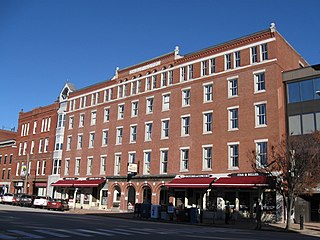
The Eagle Hotel is a historic hotel building at 110 North Main Street in Concord, New Hampshire. Built in 1851, it has been a prominent local landmark since then, and a meeting place for state politicians, given its location across the street from the New Hampshire State House. The building was listed on the National Register of Historic Places in 1978.

The Congregational Church of Goffstown is a historic Congregational church building in the center of Goffstown, New Hampshire, United States. It is a member of the Conservative Congregational Christian Conference (CCCC).
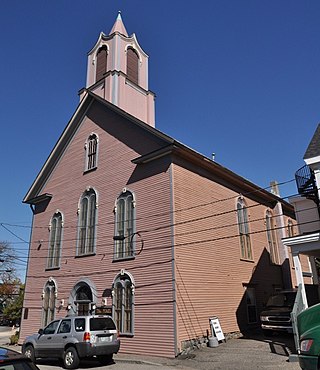
The Freewill Baptist Church—Peoples Baptist Church—New Hope Church is a historic structure built in 1868 located at 45 Pearl Street in Portsmouth, New Hampshire. The building, a fine local example of Italianate ecclesiastical architecture, was once owned by an African-American congregation. It was listed on the National Register of Historic Places in September 2002, and the New Hampshire State Register of Historic Places in January 2002. Later home to the Portsmouth Pearl, a center of arts and culture, it has more recently hosted art exhibitions, theatrical productions, and event rentals. As of June 2021, the building is listed for sale at nearly $1.5 million.

The Grasmere Schoolhouse No. 9 and Town Hall, also known as the Grasmere Grange Hall, is a historic municipal building located at 87 Center Street in the village of Grasmere in Goffstown, New Hampshire. Built in 1889 as a town hall and school, it has served a variety of civic and community functions since its construction, and is a good example of civic Queen Anne architecture. It was listed on the National Register of Historic Places in 1990.

The Union School is a historic school building at 174 Center Street in West Haven, Connecticut. Built in 1890, when the area was still part of Orange, it was West Haven's first brick school building, serving as a grammar school and high school for generations of local students. Now a senior living facility, it was listed on the National Register of Historic Places in 1987.

The Millville School is a historic school building at 2 Fisk Road, just off Hopkinton Road in western Concord, New Hampshire. Built in 1923, it is a prominent local work of New Hampshire native Chase R. Whitcher, and is Concord's only school in the Georgian Revival style. It is also the only surviving element of the historic village of Millville that is not part of the nearby St. Paul's School campus. The building was listed on the National Register of Historic Places in 1985. It now houses Parker Academy, a private day school.
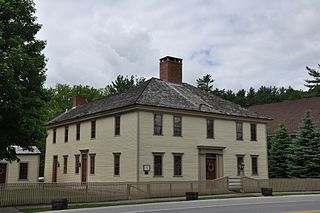
The Stanley Tavern is a historic tavern building at 371 Main Street in Hopkinton, New Hampshire, United States. The oldest portion of this Georgian wood-frame structure was built c. 1791 by Theophilus Stanley, to serve as a tavern in the town, which was at the time vying with Concord to be the state capital. It is the only surviving tavern of three that were known to be present in the town in the late 18th and early 19th century. The building was listed on the National Register of Historic Places in 2005, and the New Hampshire State Register of Historic Places in 2002.
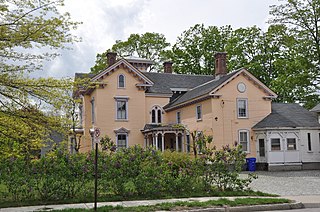
The Alpheus Gay House is a historic house at 184 Myrtle Street in Manchester, New Hampshire. Built c. 1870 by Alpheus Gay, a local building contractor, it is one of the state's most elaborate Italianate houses. The house was owned for a time by the nearby Currier Gallery of Art, but is now in private hands. It was listed on the National Register of Historic Places in 1982.

The Thomas Russell Hubbard House is a historic house at 220 Myrtle Street in Manchester, New Hampshire. The 2½-story wood-frame house was built in 1867, by a farmer turned businessman and a prosperous owner of a factory and lumberyard, and is an exceptionally elaborate Italianate villa. It was listed on the National Register of Historic Places in 1988.

The Kimball Brothers Shoe Factory is a historic factory building at 335 Cypress Street in Manchester, New Hampshire. The four-story brick building was built in stages between 1885 and 1900, and was a prototypical structure from which the design of other period shoe factories in Manchester were built. Construction was overseen by Head & Dowst, a builder responsible for a number of area public buildings, including schools and prisons. It was funded by local businessmen seeking to diversify the local economy, and was leased to the Kimball Brothers, a leading shoe manufacturer in Lynn, Massachusetts. The building was listed on the National Register of Historic Places in 1985.

The New Hampshire State Union Armory is a historic armory building at 60 Pleasant Street in Manchester, New Hampshire. Built in 1904, this large brick building was the first armory building in the state, and is a distinct example of Romanesque architecture. The building was listed on the National Register of Historic Places in 1982.

St George's School and Convent are a historic Roman Catholic complex at 124 Orange Street in Manchester, New Hampshire, United States. Built in 1898–99, they are among the city's finest examples of Romanesque architecture, built to support its burgeoning French Canadian population. The school closed in 1970, after which time the buildings have been used to house social service agencies and act as a community center. The buildings were listed on the National Register of Historic Places in 1985.

The Roger Sullivan House is a historic house at 168 Walnut Street in Manchester, New Hampshire. Built in 1892, it is the only known example of residential Queen Anne architecture by local architect William M. Butterfield, and is one of the city's finest examples of the style. It was listed on the National Register of Historic Places in 2004.

The General Porter House is a historic house at 32-34 Livermore Street in Portsmouth, New Hampshire. Built about 1751, it is a well-preserved example of a Portsmouth gambrel-roofed double house, and has been home to a number of prominent individuals. Now housing residential condominiums, it was listed on the National Register of Historic Places in 1985.

The Green Street School is a historic school building at 104 Green Street in Somersworth, New Hampshire. Built in 1890–91, it is the city's oldest surviving school, and a prominent feature of its urban core. It was converted into residences in 1983–84, and was listed on the National Register of Historic Places in 1985.

The Meredith Public Library is located at 91 Main Street in Meredith, New Hampshire. It is housed in a handsome brick Classical Revival structure designed by George Swan and built in 1900-01, with a major expansion in 1985. It was a gift from Benjamin Smith as a memorial to his parents, and is known as the Benjamin M. Smith Memorial Library. The building, one of the town's most architecturally sophisticated buildings, was listed on the National Register of Historic Places in 1984.
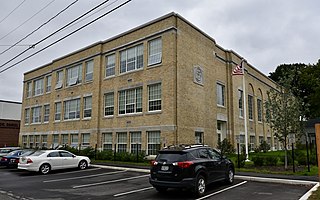
The Old Brewer High School is a historic school building at 5 Somerset Street in Brewer, Maine. Built in 1925-26, this Art Deco building was built to meet the ideals of the time for what a high school should be. The building was listed on the National Register of Historic Places in 2014.

The Champlain School is a historic former school building at 809 Pine Street in the South End of Burlington, Vermont. Built in 1909, it is a fine local example of vernacular Richardsonian Romanesque architecture, designed by one of the city's most prominent architects of the period. It was used as a school until the end of 1968, and now houses apartments. It was listed on the National Register of Historic Places in 1982.
The Immaculate Heart of Mary School is a historic school building at 10 Lincoln Avenue in Rutland, Vermont. Built in 1951, it is a rare example of International style architecture in the state, designed by Dirsa & Lampron of Manchester, New Hampshire. It was listed on the National Register of Historic Places in 2020.






















